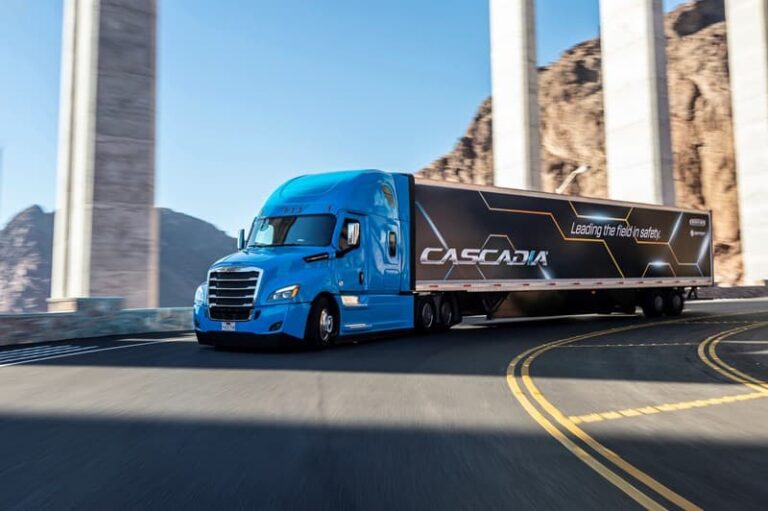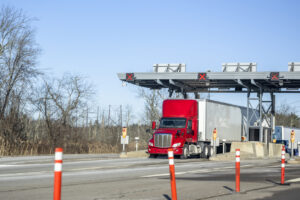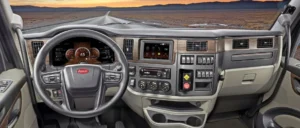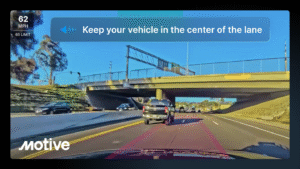LAS VEGAS — Daimler Trucks North America (DTNA) Monday introduced the first SAE Level 2 automated truck in series production in North America with the latest enhancements to the Freightliner new Cascadia.
Level 2 automation means the truck is capable of both lateral (steering) and longitudinal (acceleration/deceleration) control.
The truck is part of the revolutionary truck technologies featured by DTNA at the Las Vegas Motor Speedway during the 2019 Consumer Electronics Show (CES).
According to the National Highway Traffic Safety Administration, 94 percent of crashes are attributable to human error.
Automating acceleration, deceleration and steering reduces the chance for human error, mitigates collisions and can potentially save lives. These technologies can also enhance the driver experience by making the truck-driving task easier, thereby improving driver comfort and well-being, according to Kelly Gedert, director of product marketing for Freightliner and Detroit.
DTNA’s expertise in automation is backed by Daimler Trucks, which also said Monday at CES an investment of over half a billion dollars and an addition of more than 200 new jobs in its global push to put highly automated trucks (SAE Level 4) on the road within a decade. Most of these jobs will be located at the new Daimler Trucks Automated Truck Research & Development Center at DTNA’s headquarters in Portland, Oregon.
In May 2015, DTNA pioneered automated driving with the introduction of the Freightliner Inspiration Truck, which was the first automated truck licensed to operate on U.S. public highways.
Today, the new Cascadia delivers SAE Level 2 driving capabilities with the Detroit Assurance 5.0 suite of camera- and radar-based safety systems. This new, proprietary system marks a key milestone in Freightliner’s relentless pursuit of industry-leading overall safety, driver experience, and fuel efficiency, Gedert said.
The system can accelerate, decelerate, and steer independently. The Detroit Assurance 5.0 Adaptive Cruise Control and Active Lane Assist features make automated driving possible in all speed ranges for the first time in a series production truck, including:
- Adaptive Cruise Control to 0 mph: Improves safety, efficiency and driver comfort by automatically decelerating and accelerating to maintain a safe following distance. This technology is especially important for maintaining a comfortable driving experience in congested traffic conditions where repeated braking, accelerating and resetting of traditional cruise control can lead to driver fatigue.
- Active Lane Assist: Consists of Lane Keep Assist and Lane Departure Protection. When Adaptive Cruise Control is enabled, Lane Keep Assist supports the driver by using micro-steering movements to keep the new Cascadia centered in its detected lane. With Lane Departure Protection, if the truck begins to drift without the turn signal engaged, the system will counter steer the truck back into its lane and give an auditory and visual warning.
In addition to Level 2 automated driving features, the Detroit Assurance 5.0 active safety and advanced driver assistance systems are designed to keep truck drivers, pedestrians, cyclists, and other motorists safe:
- Active Brake Assist 5.0: The fusion of Detroit Assurance 5.0 camera and radar technology detects moving pedestrians and cyclists in front of the truck and can deploy full braking – an industry first. It can also detect and mitigate a collision with full braking on moving and stationary vehicles and objects.
- Side Guard Assist: Detects objects, including pedestrians and cyclists, in the passenger-side blind spot for the tractor and a full-length 53-foot trailer, another industry first, and delivers an audible and visual warning.
“The enhancements we’ve made to Detroit Assurance have the potential to make an immediate, measurable and positive impact on overall North American road safety,” Gedert said. “In fact, fleets with trucks equipped with forward collision mitigation systems can experience a 60 percent to 80 percent reduction in rear-end crashes, resulting in potentially fewer accidents and reduced operational costs to our customers.”
Detroit Connect Analytics provides fleets with analysis and key insights on the performance of the new Detroit Assurance 5.0 safety features. Fleets will be notified if drivers have their hands off the wheel for longer than 60 seconds.
Gedert said the new Cascadia also features one of the industry’s most efficient designs, inside and out.
“Thanks to DTNA’s significant investment in ongoing R&D in aerodynamics, powertrain development and systems intelligence, the new Cascadia delivers a 35 percent improvement in fuel efficiency compared to the first Cascadia introduced in 2007. This equates to annual savings of up to 4,700 gallons of fuel per truck, which is the amount of fuel consumed by six typical family cars in a year,” he said.
The new truck also offers aerodynamic enhancements the include Aerodynamic Height Control. An industry first, Aerodynamic Height Control electronically lowers the suspension height at 55 mph to optimize airflow over and under the front of the truck and reduce drag. Other enhancements include Michelin X Line D+ Energy tires developed in collaboration with Michelin, which reduce rolling resistance in 6×4 applications, and a low ground clearance bumper.
Gedert said another critical component of the new Cascadia’s performance is its Integrated Detroit Powertrain, a powerful combination of a proprietary heavy-duty engine, transmission, and axle that is designed to seamlessly work together for maximum efficiency. The integrated powertrain features Intelligent Powertrain Management 6, which uses the truck’s kinetic energy to automatically adjust to the truck’s surroundings by reducing braking power and making transmission and engine adjustments, saving fuel and reducing wear and tear on components.
“It’s not just the new Cascadia’s aerodynamic shape, specific options or powertrain components that make it the best – it’s that these features are engineered to seamlessly work together,” said Kary Schaefer, general manager, marketing and strategy for Daimler Trucks North America. “And we are the only truck manufacturer to offer that level of integration.”
For fleets concerned with fuel economy, Detroit Connect Analytics will also introduce new Intelligent Powertrain Management reporting capabilities, and the fuel analysis will indicate if the vehicle is using Aerodynamic Height Control, Schaefer said.
“With more than 65,000 customer deliveries to date and 50,000 on order, the new Cascadia has proven to be the Class 8 truck of choice in the industry,” she said. “We’re proud to be once again raising the bar.”
The Trucker News Staff produces engaging content for not only TheTrucker.com, but also The Trucker Newspaper, which has been serving the trucking industry for more than 30 years. With a focus on drivers, the Trucker News Staff aims to provide relevant, objective content pertaining to the trucking segment of the transportation industry. The Trucker News Staff is based in Little Rock, Arkansas.















